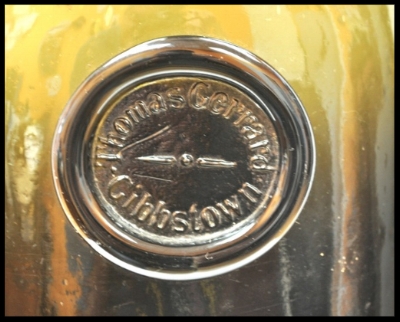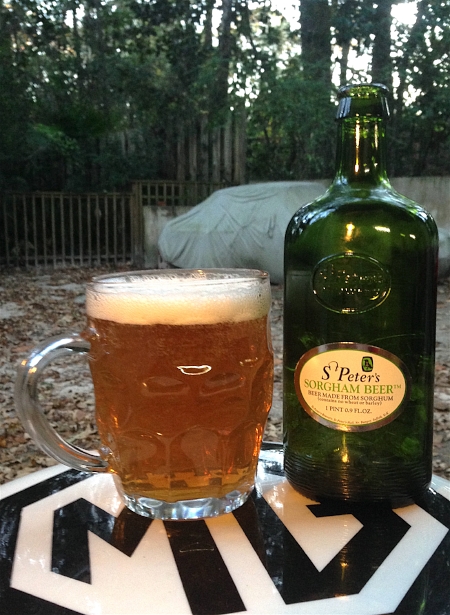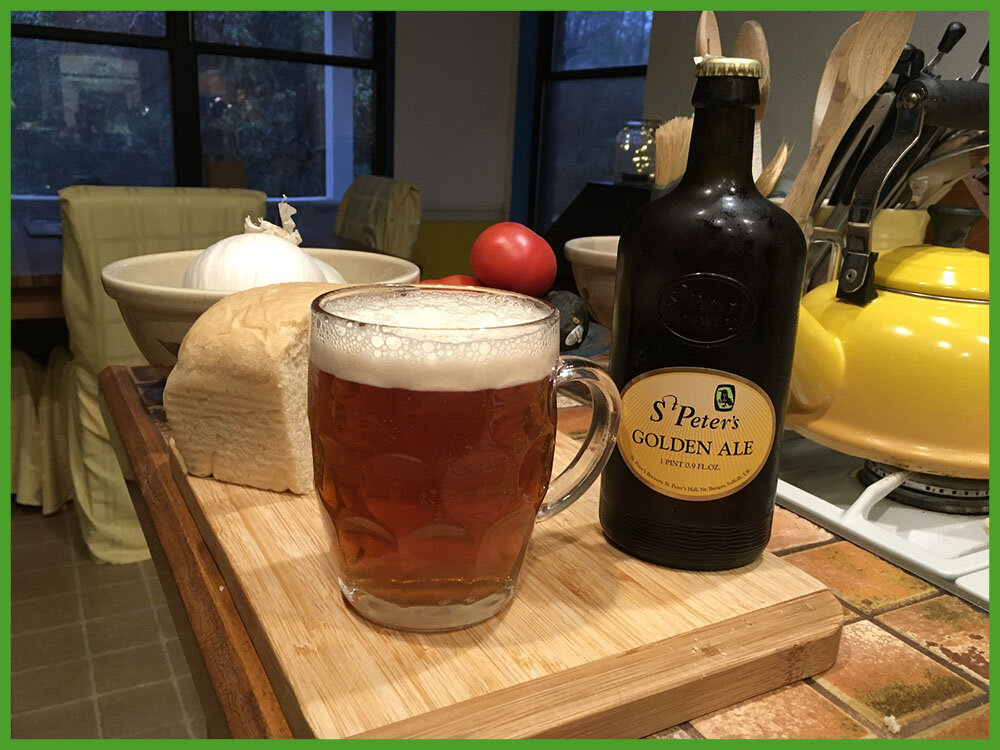St Peter's Brewery :
Cream Stout
St Peter's Dirty Tackle Ale - One darn fine ale.
By the way, the glassware seen here is called a Dimple Glass, and is a classic glass that is not seen all that much today. I prefer the Dimple Glass as the handle provides proper control over the beer delivery system, without getting your hands all wet.
So the other day I walked into my local bottle shop and asked the proprietor for something new and British. He gave me a bottle of St Peter's Dirty Tackle Ale. Certainly the label art is something to catch one's eye.
On occasion I take that first drink of a new beer and think, "Man, this is good beer." It's not something you need to work into, analyze too much, or even think about - it's just a good beer. My first taste of Dirty Tackle Ale was one such occasion. For the lover of a good traditional British ale, Dirty Tackle is for you. Nice and malty with a subtle hint of hops that compliments the sweetness of the malt, rather than masking the malt altogether.
The St Peter's Brewery is based in St Peter South Elmham, in Suffolk. Housed in some former farm buildings, the brewery opened in 1996. They use water from their own well, and attempt as much as possible to source grains and hops from the local area. Although they brew a wide range of beers and ciders, including cask conditioned, kegs and bottled beers, to date (April 2016) I have only found Dirty Tackle Ale here in North America (subject to revision). St Peter's also brews a wide variety of seasonal offerings, so the menu, if you will, is changing all the time. The importer - EuroBrew - lists several other St Peter's products on their website, so I will have to keep an eye out.
Like I said, I will keep on the lookout for more St Peter's beer, and will report back accordingly.
Another real winner from the folks at the St Peter's Brewery - their Cream Stout. What can I say, it's nice and stout, as it should be, with a velvety smooth - shall I say creamy - feel. Just one good cream stout. Try it if you can find it.
A little bit of symbology here - St Peter's Brewery's black raven and the key.
About the Bottle: One of the best things about the unique oval shaped St Peter's bottle, besides the fact that is a historical throwback, is that it is easy to spot on the shelves - thanks for that. This bottle is a reproduction of ones that were made - circa 1770 - for an innkeeper by the name of Thomas Gerrard, who kept an establishment in the town of Gibbstown, New Jersey - just across the Delaware River, near Philly, in the U.S. Some references indicate this type of bottle was originally used for gin.
Here is a close up of an actual Thomas Gerrard bottle that recently sold at action for 300 bucks. St Peter's Brewery uses a similar type of marking on their beer and ale bottles.
St Peter's Old-Style Porter - Another darn good offering from the folks at St Peter's - rich, smooth and malty. Wonderful
About the Bird: I have always been interested in the artwork one finds on the label on a bottle of beer. Some are easily self explanatory, while others are not so much. When I found my first bottle of St Peter's Cream Stout I immediately wondered what was meant by the black bird, and what I assumed was a key or keys.
Now in the world of symbology the key has many meanings, the most basic being a symbol of knowledge and success - the unlocking of a door to both. Keys appear singularly, and in twos and threes, sometimes crossed. Of course, one of the most well known applications of the key motif is the Keys to Heaven, which were given by Jesus to St Peter. Although it is a rather loose connection, there is a bit of a connection between the biblical St Peter and the brewery St Peter. More on that below.
Other manifestation of the key symbology is the two golden crossed keys denoting membership in an organization called Les Clefs d'Or, which is a order consisting of hotel lobby concierges. Membership in Les Clefs d'Or indicates a high level of training and consistently impeccable service to hotel guests. So what about the black bird and the key?
In the book "Topographical Dictionary of England" by Samuel Lewis - published in 1831 - the area where today's brewery is sited is described thusly: Elmham (South) St Peter, a parish in the hundred of Wangford, county of Suffolk, 3 3/4 miles (s) from Bungay, containing 139 inhabitants. A later reference, in the book "The History and Antiquities of the County of Suffolk, Volume 1" by Alfred Suckling - published in 1846 - describes St Peter South Elmham as a small village, the most prominent feature being a large manor hall - St Peter's Hall. Although neither of these references make note specifically, it can be assumed that this St Peter's Hall, as well as the closeby church, were both named for the biblical St Peter. In any case, the St Peter's Brewery is named for St Peter's Hall, and is housed in some of the manor's old outbuildings.
A few weeks ago (October 2016) I dropped the brewery a message asking the meaning of their emblem. I got a nice reply from Emily, and she informed me that the black raven represents the protection of tSt Peter's inhabitants from the onslaught of Vikings, and prevents them from crossing the moat that surrounds the manor. The key, naturally enough, represents the lock to the gates of St Peter's Hall. Thanks Emily. And, now you know the story.
From the 1912 edition of the Genealogical and Heraldic History of the Landed Gentry of Ireland. Seems there were Gerrards living in Gibbstown, County Meath, Ireland - did they cross the pond and start a new Gibbstown in Jew Jersey?
Alot of "Saint" places around this part of the UK. St Peter's did not make this map - a U.S. Army map, circa 1956. It is located just southeast of the letter "n" in Flixton.
No barley in this beer....Whaaa? Historically, back in the really old, olden days, folks would ferment just about any grain they could get their hands on. No barley available, well let's try sorghum. To be honest, I was a bit skeptical at first, but found this to be a very tasty beer. Yup, light and tasty, a bit pilsnery and very refreshing. I just checked the St Peter's website and it appears that this variety is no longer on offer - as of November 2017 - so if you happen to find a few bottles still on the shelves, buy it and enjoy.
Well, to be honest, I can't really tell, but St Peter's Organic English Ale is kinda cool, being organic and all. It's a darn good ale - a bit lighter and a bit hoppier - quite refreshing.
I had to drive 50 miles - to get outside of Florida - to find a couple of pints of St Peter’s Golden Ale. Thank goodness for my favorite Mobile, Alabama, package store. St Peter’s Golden Ale - a darn fine pint. Nice and malty, with maybe a bit more hop bitterness. Not to worry if you are not a hophead as the hop bitterness works well, and is not overpowering. Cheers.










